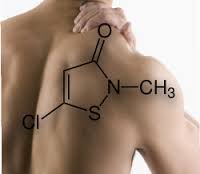
Recently, we have been getting a lot of correspondence from people around the Globe that have discovered they have allergic reactions to Isothiazolinones. If and if is the key word the ingredient deck on your products disclose this potential problem it would be listed as Methylisothiazolinone or Benzisothiazolinone.
What we feel is important to understand is that these ingredients are added to products to preserve them from potential bacteria and both the conventional products and many Big National Brands continue to use these because they are inexpensive and help with manufacturing by killing contaminants introduced in the process or present in the other ingredients.
So that’s the “upside” of keeping them in the formulations that usually are made in many locations by contract packagers not the brand manufacturers themselves. The downside is that many people get sensitized to this ingredient with minimal exposure and develop contact dermatitis which is uncomfortable, unsightly and can lead to further tissue damage if not treated properly. Furthermore, most dermatologists are not keen to the chemical connection and prescribe creams, ointments and steroids as oppose to guiding an elimination of the source products.
Our position with all of our client’s products is to eliminate completely this preservative system and use the alternatives. It’s only a matter of time before the industry or Governments decide this is a public health concern and then the big brands will be scrambling. In the end like all change, better practices and technologies will take over. Our team is constantly reviewing new, safer preservative systems as well as reviewing the total ingredient toolbox to try to bring the highest performing, safest products possible through the traditional distribution channels.
For more information on products without MI or BI please visit http://isothiazolinone.tumblr.com/

